 HOe Models of 760mm (2'6") Austrian Narrow Gauge Railways.
HOe Models of 760mm (2'6") Austrian Narrow Gauge Railways. 
Back
| ÖBB Di/s 6492 |
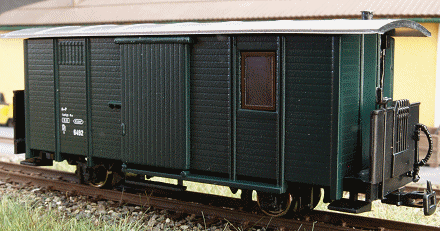 |
order # 0162 |
The ÖBB's Di/s 6492 service van was converted from a covered goods van.
It was fitted with a service compartment, one window on either side and doors to the platforms.
The service compartment was occasionally heated by means of a simple stove.
The wagon was found on almost all of the ÖBB's narrow-gauge lines.
Back
| ÖBB Di/s 6494-4 |
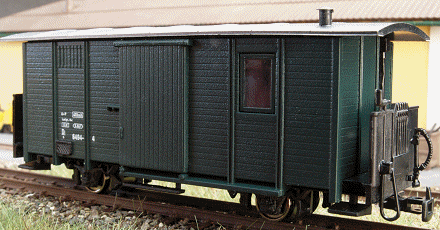 |
order # 0163 |
The ÖBB's Di/s 6494-4 service van was converted from a covered goods van.
It was fitted with a service compartment, one window on either side and doors to the platforms.
The service compartment was occasionally heated by means of a simple stove.
The wagon was found on almost all of the ÖBB's narrow-gauge lines.
~~~~~~~~~~~~~~~~~~~~~~~~~~~~~~~~~~~~~~~~~~~~~~~~~~~~~~~~~~~~~~~~~~~~~~~~~~~~~~~~~~~~~~~~~~~~~~~~~~
Back
| L.B.M.-St.E. O 105 |
 |
order # 0124 |
This wagon was supplied by O&K as 3-axle high-sided wagon with brakeman's cabin Jk 105 as early as 1913.
In the late fifties it was fitted with a steel body for the transportation of magnetite as Kk/p 105.
More recently the side-panels were dismantled and the top part of the front ends trimmed.
It is now named O 105 and used to carry pallets (up to 4 pallets placed side by side).
Back
| L.B.M.-St.E. O 117 |
 |
order # 0126 |
This wagon was originally supplied as a 6-wheel high-sided wagon with brake platform Jk 117.
It was one of the first wagons to receive a tent-line tarpaulin. In the late fifties it received a metal body and was assigned the lettering Kk/p 117.
Now the sides have been removed and the upper part of the ends trimmed.
It is now named O 117 and used for carrying pallets.
Back
| L.B.M.-St.E. O 142 |
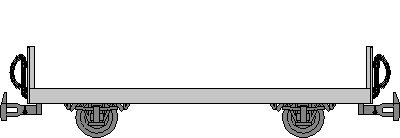 |
order # 0125 |
This wagon had been supplied by the firm Knotz as Omp 142, an open goods wagon with a tent-like tarpaulin roof.
More recently, the sides have been removed and the top part of the front ends cut off.
It is now numbered O 142 and used for carrying pallets (up to 4 pallets side by side).
Back
| L.B.M.-St.E. Kk/p 103 |
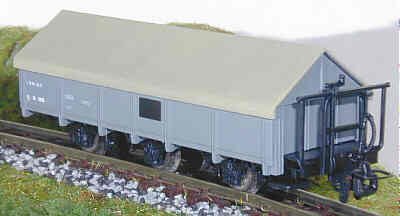 |
order # 0127 |
This wagon was rebuilt from a high-sided wagon with brakeman's cabin supplied by Orenstein & Koppel in 1913.
The wooden bodywork was replaced by steel panels in the 1956/60 period and the new structure was covered with a roof-like tarpaulin.
One end features discharge openings.
The brakeman's platform is reinforced with a massive steel angle section.
Back
| L.B.M.-St.E. 104 |
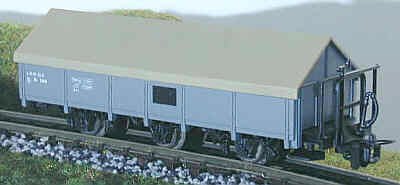 |
order # 0131 |
Back
| L.B.M.-St.E. 114 |
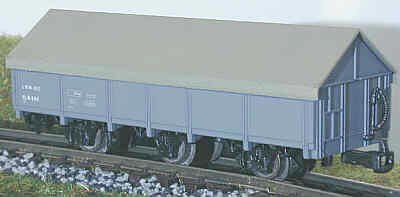 |
order # 0129 |
Back
| L.B.M.-St.E. 115 |
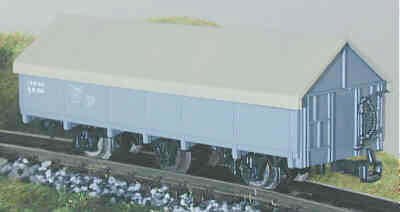 |
order # 0132 |
Back
| L.B.M.-St.E. Kk/p 119 |
 |
order # 0123 |
This wagon was rebuilt from a standard high-sided wagon.
The wooden planks were replaced by steelwork and the body covered with a tent-like tarpaulin.
One of the ends featured discharge openings.
In contrast to other, similar wagons this one remained unmodified, keeping its original brake platform.
The wagon was stationed at Kapfenberg from 1947 to 1957.
~~~~~~~~~~~~~~~~~~~~~~~~~~~~~~~~~~~~~~~~~~~~~~~~~~~~~~~~~~~~~~~~~~~~~~~~~~~~~~~~~~~~~~~~~~~~~~~~~~
Back
| �BB Gw 10 012-8 |
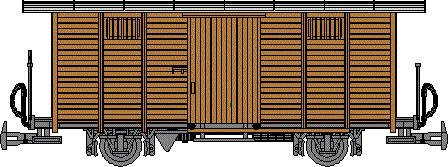 |
order # 0137 |
The Gw 10012-8 looks back on an eventful past.
Grazer Waggonfabrik delivered it to Bregenzer Wald Bahn in 1908, where it operated as G 248.
In the BB� era it was assigned number 1055.
After brief stints on almost all of the �BB's narrow-gauge lines (lettered Gw/s 10012) it finally served as maintenance van (Bahnmeisterwagen) at Mittersill on the Pinzgauer local line.
Back
| �BB Gw/s 10 015-1 |
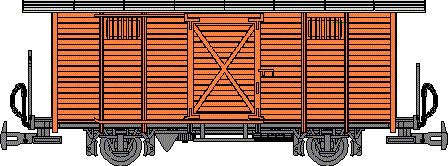 |
order # 0109 |
The 2-axle Gw/s 10 015-1 is one of the few closed vans that have survived unchanged since the early days of Austrian narrow-gauge railways, now bearing �BB lettering.
In 1993 the van was seen on the Mariazeller line in the area of St. P�lten, still with the characteristic sliding doors with diagonal reinforcement.
Even its light-brown livery largely retained its original appearance.
The van is fitted with two platform railings, a hand brake and a vacuum brake.
Back
| �BB G/s 11 660-3 |
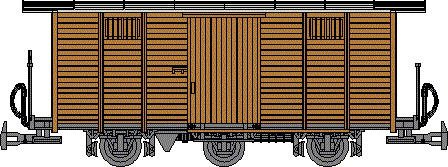 |
order # 0061 |
This van was built by Simmeringer Waggonfabrik in 1912 and delivered to Mariazellerbahn as Gy/s 813.
From 1928, it was assigned the BB� number 1529.
More recently, the van was lettered G/s 11 660-3 and, until the termination of goods traffic, served as a general purpose cargo, post and luggage van.
The platform railings have never been changed, only the roof has been converted to the sheet metal-type.
Back
| �BB Hw/s 20 237 |
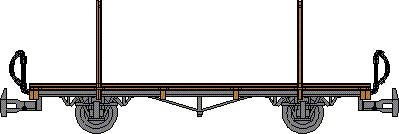 |
order # 0092 |
Logs and timber have always been the by far most important freight carried by Austrian narrow-gauge railways.
Highly specialised log carriers have therefore been used from a very early stage.
Hw/s 20 237 is a flat wagon with plug-in stakes specially suited for the transport of sawn timber.
The presence of stakes and a strut frame indicates that the wagon was designed primarily for the transport of stacks of sawn timber of up to three metres length.
The wagon was delivered by Grazer Waggonfabrik in 1898.
Back
| �BB Sw/s 30 210 |
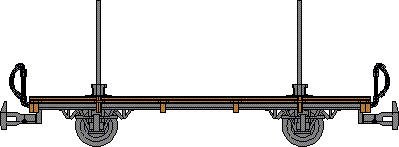 |
order # 0093 |
This wagon is from a series built for Ybbstalbahn in Graz in 1896.
As a special feature the wagon was fitted quite early with non-pivoting hinged stakes.
These stakes fold down, forming a ramp that greatly facilitates manual loading of logs.
The wagon is unbraked but fitted with a continuous brake line.
The brake hoses also fold down from a vertical into a horizontal position.
Back
| �BB Sw/s 30 251 |
 |
order # 0133 |
Sw/s 30 251 was delivered by Grazer Waggonfabrik to Ybbstalbahn as early as 1896 and assigned number 2057 by BB�.
Fitted with plug-in stakes, the wagon was probably designed mainly for the transport of sawn timber of 4 to 6 m length placed lengthwise onto the body.
The wagon is equipped with the standard vacuum brake system and the hand-operated brake crank that is typical of Austrian narrow-gauge rolling stock.
Back
| �BB Sw/s 30 260 |
 |
order # 0134 |
The �BB Sw/s 30 260 flat wagon was supplied to Ybbstalbahn by the Simmering works in 1920.
In the BB� era, the wagon carried number 2058.
The brake platform is separated from the loading area by a 5-plank wall.
The wagon is fitted with the standard vacuum brake system.
In the prototype, the brake hose at the end of the loading platform folds down into horizontal position.
The wagon was used primarily for carrying sawn timber.
Back
| �BB Jbm/s 34 601- 4 |
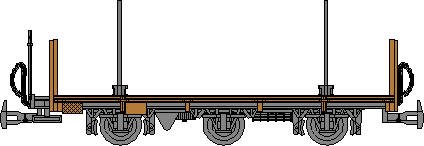 |
order # 0091 |
Jbm/s 34 601- 4 was delivered by Simmering to Mariazellerbahn as wagon 310 and, after 1937, operated by BB� as Jkey/s 5934.
The same type of wagon was also running on Pinzgauerbahn.
From 1955, a number of wagons were rented out to StLB for the Weiz - Ratten line.
In 1971 ownership passed to StLB. The iron stakes are not of the pivot-type but can be folded down sideways to serve as a loading ramp for logs.
Back
| �BB Ow/s 60 250 |
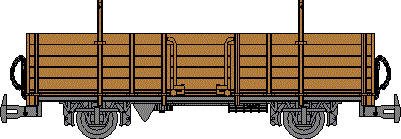 |
order # 0115 |
In the heyday of Austrian narrow-gauge railways five-plank high-sided wagons were running in large numbers.
Braked types were usually fitted with brakeman's platforms and hand-operated brakes.
Wagons without platforms generally did not have any braking devices.
15 five-plank wagons of the series Ow/s 60 250 - 264 and 15 four-plank wagons, however, were equipped with vacuum brakes.
This model carries �BB lettering.
Close spacing of the stakes allows transportation of a wide variety of loads.
Back
| �BB O/s 61 507 |
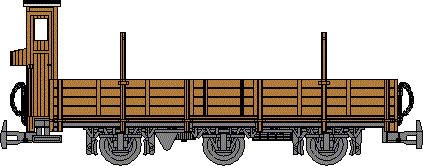 |
order # 0118 |
Grazer Waggonfabrik built this wagon for Waldviertler Bahn in 1900.
BB� assigned to it number 4230. The wagon features a centrally placed brakeman's cabin.
The hand brake is housed in a box, sheltered from the weather.
The 6-wheel underframe is of conventional design.
The low sides indicate that the wagon was used primarily for the transport of heavy bulk goods such as gravel, sand, and coal.
Back
| �BB s96 210-5 |
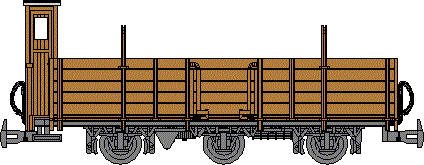
|
order # 0073 |
The �BB scaffold wagon /s96 210-5 is a typical 6-wheel high-sided wagon with the characteristic off-centre brakeman's cabin.
It's use as a scaffold wagon allowed it to survive several goods van scrapping campaigns.
It usually carried a working platform (scaffolding) mounted on its loading area and forms part of work trains.
It is typically used for painting and masonry work and for tunnel inspections.
Back
| �BB Di/s 6492-8 |
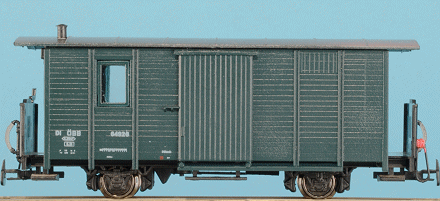 |
order # 0164 |
The ÖBB's Di/s 6492-8 service van was converted from a covered goods van.
It was fitted with a service compartment, one window on either side and doors to the platforms.
The service compartment was occasionally heated by means of a simple stove.
The wagon was found on almost all of the ÖBB's narrow-gauge lines.
Back
| �BB X 90301 |
 |
order # 0038 |
This 4-wheel low-sided wagon is stationed at Mittersill, from where it is operated as a maintenance car on the Pinzgauer local line.
The brakeman's platform features the common hand-operated brake.
The wagon is frequently seen without its plug-in stakes.
Back
| �BB 97011-6 |
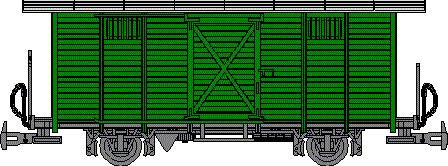 |
order # 0105 |
The two-axle equipment van is one of the few closed vans dating back to the very beginnings of Austrian narrow-gauge railway operations and still being used by �BB in almost unchanged condition.
The van comes in its authentic fir-green livery with the characteristic diagonally reinforced sliding doors.
The lettering of the model is a precise representation of the prototype which bears slightly different inscriptions on its sides.
The van is fitted with a hand brake and a vacuum brake.
~~~~~~~~~~~~~~~~~~~~~~~~~~~~~~~~~~~~~~~~~~~~~~~~~~~~~~~~~~~~~~~~~~~~~~~~~~~~~~~~~~~~~~~~~~~~~~~~~~
Back
| StLB G 4002 |
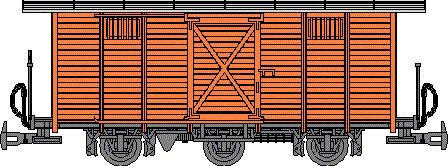 |
order # 0114 |
The light-brown 6-wheel van with brakeman's platforms at both ends still features the sliding door with diagonal reinforcement that is so typical of very early Austrian stock.
One of the platforms is fitted with a hand-operated brake.
In contrast to the vans running on other narrow-gauge lines StLB vans with 2 platforms usually had doors at the ends.
Some of these vans still operate on a number of lines as part of museum trains.
Back
| StLB G 4009 |
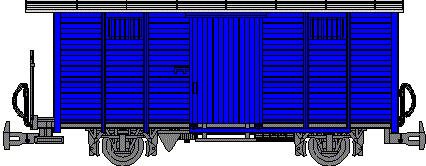 |
order # 0063 |
The two-axle bicycle van G 4009 of the Stainz local line with its bright-blue livery has highly visible sign boards on its sliding doors bearing a white bicycle symbol.
On one end, the van has a covered brake platform.
It is used primarily for special outings with the well-known Stainzer Flascherlzug.
Back
| StLB G/s 109 |
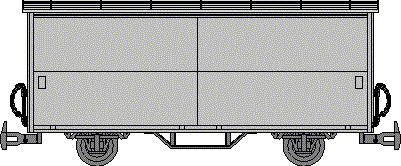 |
order # 0113 |
Steierm�rkische Landesbahnen have modernised some of their covered goods vans.
Body sides have been removed completely and replaced by two metal sliding doors.
The front ends were retained in their original condition.
The large sliding doors now enable loading of the van with pallets by means of a fork lift running on a ramp.
In addition, the G/s 109 has been fitted with a trapezium truss to prevent the underframe from bending under heavy loads.
The van is unbraked but has a vacuum brake line running along its entire length.
Back
| StLB G/s 122 |
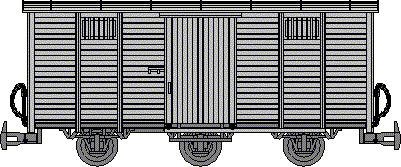 |
order # 0064 |
Grey vans and wagons can frequently be spotted on the numerous lines of Steierm�rkische Landesbahnen.
Today, almost all goods wagons on the Weiz - Birkfeld line come in grey liveries.
The 3-axle closed goods van is unbraked but fitted with a vacuum brake line running its full length.
It is one of the goods vans that date back to the early times of Austrian narrow-gauge railways, yet have retained their external appearance virtually unchanged.
The G/s 122 running number is printed in black, true to the prototype.
Back
| StLB H 165 |
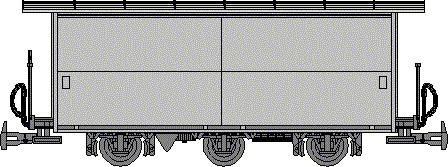 |
order # 0086 |
Feistritztalbahn (Weiz -Birkfeld) handles primarily the freight traffic for the talc mill of Oberfeistritz.
To make transportation of pallets easier, the sides of many closed goods vans have been replaced by large sliding doors that allow easier access for forklifts.
StLB H 165 with a 3-axle underframe and platforms at either end is a typical example of wagons of this generation.
Back
| StLB G16 |
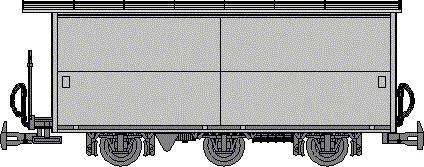 |
order # 0090 |
Back
| StLB O/s 261 |
 |
order # 0071 |
The high-sided wagon StLB O/s 261 was previously known as Jk 131.
Below its current grey coat of paint, now occasionally found to be peeling off, one can still detect traces of the former dark-brown livery.
The wagon is a typical example of the open goods wagons that were once common on all Austrian narrow-gauge lines.
In its grey livery it is representative of the rolling stock now in service on the Weiz - Birkfeld line.
Back
| StLB Jkm 378 |
 |
order # 0160 |
This 4-wheel low-sided wagon is operated as a maintenance car on the Murtal local line.
The brakeman's platform features the common hand-operated brake.
Back
| StLB G4106 |
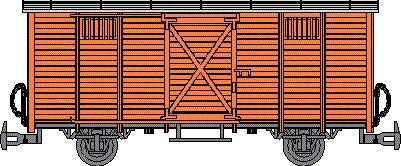 |
order # 0106 |
Even today the light-brown van still has the sliding door with diagonal reinforcement typical of very early Austrian stock.
The van is unbraked but fitted with all-through vacuum brake installations.
In January 1996 it was spotted on the Jagsttal line in Germany with original StLB lettering.
The model represents the prototype as it was last in service on the Steiermark lines.
Back
| StLB X370 |
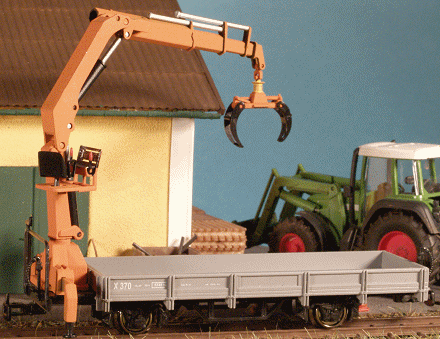 |
order # 0155 |
The crane wagon X370 was seen in October 1994 at Weiz station.
It did not have an owner inscription.
The hydraulic crane, mounted on the brake box, had a log grab attachement fitted for the loading of wood.
The hydraulic crane on the model is moveable.
~~~~~~~~~~~~~~~~~~~~~~~~~~~~~~~~~~~~~~~~~~~~~~~~~~~~~~~~~~~~~~~~~~~~~~~~~~~~~~~~~~~~~~~~~~~~~~~~~~
Back
| ThB G 4015 |
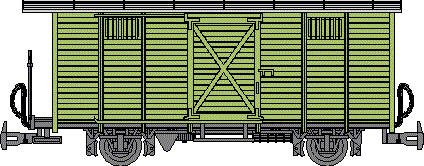 |
order # 0116 |
The two-axle closed van of the Th�rlerbahn local line with light green livery has a bicycle symbol on each sliding door, one pointing to the right, the other to the left.
The van is fitted with the standard vacuum brake used on narrow-gauge rolling stock in Austria and has one brakeman's platform.
The model echoes the striking colour and interesting lettering of the prototype with great precision.
Today, the van is used both as a service wagon for passenger trains and as a mobile tool-shed.
Back
| ThB G 4016 |
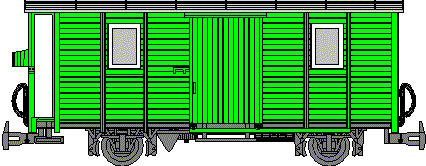 |
order # 0108 |
The Th�rler Bahn two-axle closed van with brake platform has some special features.
With its grass-green livery it is a true eye-catcher.
Also, it is the only narrow-gauge goods van with 4 windows and white window frames.
The brake platform with its central wood panel forms a kind of brakeman's cabin and has a door leading into the inside of the van.
The hand brake handle is enclosed.
~~~~~~~~~~~~~~~~~~~~~~~~~~~~~~~~~~~~~~~~~~~~~~~~~~~~~~~~~~~~~~~~~~~~~~~~~~~~~~~~~~~~~~~~~~~~~~~~~~
Back
| Set of four Tipper Buckets |
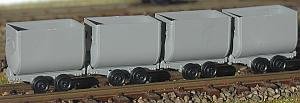 |
order # 0158 |
~~~~~~~~~~~~~~~~~~~~~~~~~~~~~~~~~~~~~~~~~~~~~~~~~~~~~~~~~~~~~~~~~~~~~~~~~~~~~~~~~~~~~~~~~~~~~~~~~~
Call Winco 0 196 286 9301 Monday to Friday - 10am to 9pm (UK time) »» from outside UK ++ 44 196 286 9301
Back






































